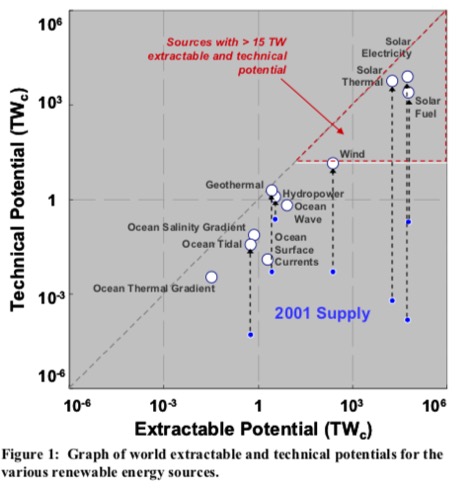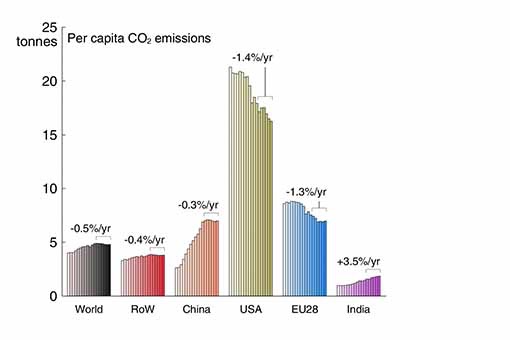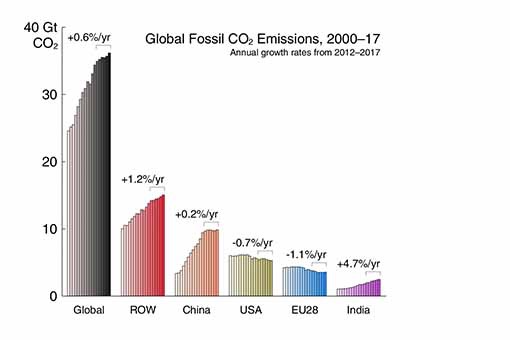Something to keep in mind…
we must think and act now
in ways that take into account
…
the possibility that we will not be able to do
…
the kinds of interventions in the future
…
that we will be able to do now
.
Rupert Read
.
Solar with a sprinkling of nuclear ~ What’s realistic?
This 2006 Sandia Labs paper focuses on world energy needs and suggests ways to become carbon neutral.
Sandia scientists have worked extensively on nuclear and solar energy research. Experts within and outside of Sandia contributed to this paper which is well worth reading. Their website also has a great deal of information.
Whatever you think about nuclear energy, nuclear power does not currently have the capacity to solve our energy problems. We cannot build the number of reactors needed to both capture and sequester the necessary amount of carbon in time. More importantly there is not enough uranium to power them for more than ten years. (See specifics below)
Their conclusion is that only solar has the potential scale to meet this challenge.
What are the world’s energy needs?
Projected world energy consumption per year:
• 2001 – 13.5 TW
• 2050 – 27.6 TW
• 2100 – 43 TW
• The world’s current yearly total energy requirements are 15TW per year.
(TW: terawatt = 1 trillion watts = 10 billion 100 watt light bulbs running simultaneously)
Projected Carbon emissions:
• 2001 – 6.6 GtC
• 2050 – 11.0 GtC
• 2100 – 113.3 GtC
(1 Gt: gigatonne = 3.67 Gt CO2)
Based on the ocean’s ability to absorb CO2, all future emissions must be absolutely limited to 1-2 GtC/yr.
This requires that emissions do not exceed the 6.6 GtC/yr level of 2001 emissions.
An important conclusion of the paper is to act now. If we wait to go C-neutral the problem becomes much harder.
We need about 15TW of total energy in the form of carbon neutral energy in order to stop emissions.
Could all of Earth’s needs for C-neutral power be derived from fossil fuels?
Not easily. All CO2. output from fossil-fuel power plants would need to be sequestered.
Could all of Earth’s C-neutral power be derived from sources that produce electricity?
No. Electricity is considered to be “high-grade” form of energy and is 3x more expensive than energy burned directly to power vehicles or heat houses. To be cost-competitive with current fuels, the price would have to be reduced to $0.02/kWh.
A worldwide adoption of a carbon tax would change this equation and make alternative energy sources cost-competitive. Since electricity would need to be used to generate fuels that are portable, an additional 1-3x in cost reduction may be necessary.
Some challenges associated with supplying C-neutral nuclear power
To produce 15 TW by 2050 would require roughly 14,636 new 1-GWe nuclear power plants. Construction of this number of plants would require, on average, the commissioning of a new nuclear power plant somewhere in the world every day continuously for 40 years.
These “slow-neutron” style reactors are:
• very expensive to build,
• require huge amounts of energy during construction.
• have safety issues,
• there is also only enough uranium in the earth to power these plants for 10 years once they are all operational.
So, it is extremely unlikely that traditional nuclear technology can solve the problem.
However, the development of new “fast-breeder” reactor designs may change this equation. Fast-breeder reactors generate their own fuel as they run, therefore availability of uranium would not be a problem. Numerous people are funding efforts to develop such technology.
Which renewable energy resources have the greatest potential for supplying 15 TW of C-neutral power?
The paper includes an excellent analysis of this question, investigating the various forms of renewable energy, including solar (photovoltaic, concentrated, and biomass), wind, ocean waves, and geothermal.
The conclusion of the analysis is clear – only solar has the potential to scale to meet this challenge.
What is the potential of solar energy?
The sun delivers more energy to Earth in an hour than we use in a year from fossil, nuclear and all renewable resources combined! Good news!
This theoretical potential could be used to generate 15 TW of C-neutral power from 10%- efficient solar-conversion systems covering only 0.17% of the Earth’s surface area.
To supply the (smaller) power that the U.S. consumed in 2001 (3.24 TW) with similarly efficient solar conversion systems would require a correspondingly smaller surface area. This is roughly 1.9% of the surface area (9,631,418 km2), and 2.0% of the land area (9,161,923 km2), of the U.S.
It is also roughly 30 times the total roof space (5,800 km2) that was estimated to be available in 2003 for photovoltaics in the U.S. It is comparable to the 1-1.5% of the U.S. land area that is covered by the nation’s public roads; and is comparable to the land area of North Dakota (178,694 km2) or South Dakota (196,576 km2).
Altogether, the technical potentials can be estimated to be:
• Solar electricity: 89,000 TWc · (1-0.708) · (1-0.0345) · (0.3) = 7,500 TWc
• Solar fuels: 89,000 TWc · (1-0.708) · (1-0.0345) · (0.1) = 2,500 TWc
• Solar thermal: 89,000 TWc · (1-0.708) · (1-0.0345) · (0.225) = 5,600 TWc
An important chart from the paper 
HOT AIR NEWS ROUNDUP
Coal is the largest contributor to the human-made increase of CO2 in the atmosphere, 40% of the total. Coal has the highest carbon intensity per energy unit produced of all fuels. The Union of Concerned Scientists has an excellent website on all aspects of coal. This is an excellent article. Go check it out…
Global fossil fuel emissions have climbed upward for a second straight year, driven by growing energy use
Stanford News December 5, 2018
“Global energy demand is outpacing powerful growth in renewables and energy efficiency,” said Jackson, who is also a senior fellow at Stanford’s Woods Institute for the Environment and Precourt Institute for Energy. “The clock is ticking in our struggle to keep warming below 2 degrees.”
…
In the United States, emissions of carbon dioxide are projected to increase 2.5 percent in 2018 after a decade of declines. Culprits for the increase include unusual weather – a cold winter in Eastern states and a warm summer across much of the nation ramped up energy needs for seasonal heating and cooling – as well as a growing appetite for oil in the face of low gas prices.
“We’re driving more miles in bigger cars, changes that are outpacing improvements in vehicle fuel efficiency,” Jackson explained. Overall, U.S. oil use is on track to rise by more than 1 percent this year compared to 2017.
…
Energy demand is rising around the world. “It’s the first time in a decade that the economies of essentially all countries are growing,” said Jackson.
According to the study, the biggest change in carbon emissions this year compared to 2017 is a substantial uptick in both energy consumption and emissions in China. After four years of stable emissions amid pressure to improve air quality, the country has now hit the accelerator.
Global economic growth has increased demand for iron, steel, aluminum and cement manufactured in China. Meanwhile, a recent slowdown in China’s own economy prompted the country to shift its approach to energy development.
“China is jump-starting coal projects that were on hold,”
‘Brutal news’: global carbon emissions jump to all-time high in 2018
The Guardian December 5, 2018
Almost all countries are contributing to the rise, with emissions in China up 4.7%, in the US by 2.5% and in India by 6.3% in 2018. The EU’s emissions are near flat, but this follows a decade of strong falls.
…
In the three years since the Paris agreement was signed, financial institutions have invested more than $478bn in the world’s top 120 coal plant developers, according to a report by the NGOs Urgewald, BankTrack and partners. Chinese banks led the underwriting of coal investments, while Japanese banks led the loans, the NGOs found.
In the US, emissions rose as an unusually cold winter and hot summer boosted demand for both heating and cooling in homes.
Interesting thoughts on the Green New Deal…
Why the Green New Deal Is the Stuff of Fantasyland
Naked Capitalism January 15, 2019
The false promise of the Green New Deal is that we can keep our high-consumption lifestyles. A lot of oxen would need to be gored if the public were to cut way back on activities like air travel that do a lot of damage. How many people are prepared to fly at most once a year or once every five years, to deal with a real emergency? And what would that do to jobs and investment portfolios? While Japan had enough social cohesion to embrace shared sacrifice in its post-bubble era (executives and top managers took permanent pay cuts to preserve employment), that capacity is notably absent in the US.
…
The Green New Deal would emulate its predecessor’s use of public investment and hiring, improvement of wages, and socioeconomic safety nets to accelerate economic growth and reduce unemployment. That part of the vision should be pretty straightforward. But in asking whether success in reaching those economic goals could also help head off ecological catastrophe, we first need to take into account how the original New Deal worked, both as a civilian project and as it morphed into the war effort of the 1940s.
…
The Green New Deal would not achieve an economic transformation; rather, it would hitch its sustainable-infrastructure investment and taxation reforms to the existing economy. It would leave the private sector untethered, free to produce for profit rather than for quality of life. Inevitably, pressure would build to crank the dirty energy back up.
To avoid that disaster, we need a strict national emissions ceiling that declines steeply year by year. Across the economy, resources must be diverted by lawaway from destructive and superfluous production, toward meeting human needs. Likewise, abuse of land, water, and ecosystems must be outlawed, no matter how much money-pain it causes those who’ve been enriched by that abuse.
This is a great article with lots of graphs…
2019 may be the warmest year on record as a result of an El Niño event exacerbated by global warming
World Resource Institute Yahoo News December 24, 2018
There is a 90 percent chance that El Niño will form and continue through the Northern Hemisphere winter of 2018-19 and a 60 percent chance that it will continue into the spring of 2019, according to the Climate Prediction Center at the National Oceanic and Atmospheric Administration (NOAA)
…
“What’s interesting is that 2018 started out under La Niña conditions, which usually has a cooling influence on global temperatures, but it was not nearly enough to cancel out the warming from the release of man-made greenhouse gases,” Anderson said.
…
The years 2014, 2015 2016 and 2017 all rank in the top four warmest years on record globally, ocean and land combined, with data going back to 1880, according to the National Aeronautics and Space Administration (NASA).
“It’s not hard to see that with the potential added boost from another El Niño that 2019, or even 2020, is a pretty good bet to take out some of those years from the top four list,” Anderson said.
Climate change: Need for multipronged vision stressed
The Hindu January 11, 2019
on Thursday called for strategies that emphasised local-level planning and multidisciplinary approaches to effectively tackle climate change.
A training programme on ‘Climate Change and Disaster Mitigation’ organised here by the Institute for Climate Change Studies (ICCS) under the Environment Department looked at how the phenomenon impacted agriculture, town planning, and fisheries.
Car Companies Aren’t Even Trying to Sell Electric Cars
Climate Change News January 15, 2019
This week at the North American International Auto Show in Detroit, manufacturers are making good on their promise to phase out sedans in favor of more popular trucks and SUVs. They are also making limited progress on their goal of building cheaper, better-performing electric cars. But make no mistake, electric vehicles are still a side show for automakers.
Warning: A ‘Shrinking Window’ of Usable Groundwater — and the Oil and Gas Industry Isn’t Helping
Climate Change News January 13, 2019
We’re living beyond our means when it comes to groundwater. That’s probably not news to everyone, but new research suggests that, deep underground in a number of key aquifers in some parts of the United States, we may have much less water than previously thought.
Climate Breakdown is getting traction at top level mainstream news…
Antarctica ice melt has accelerated by 280% in the last 4 decades
CNN January 8, 2019
A pair of new studies released on Monday share a same ominous message — that our planet’s ice is melting at an alarming rate, which is bad news for global sea levels.
New U.S. Oil and Gas Drilling to Unleash 1,000 Coal Plants’ Worth of Pollution by 2050
Climate Change News January 15, 2019
By 2030, the U.S. is on track to produce 60 percent of the world’s new oil and gas supply, an expansion at least four times larger than in any other country. By 2050, the country’s newly tapped reserves are projected to spew 120 billion metric tons of carbon dioxide emissions into the atmosphere.
That would make it nearly impossible to keep global warming within the 2.3 degrees Fahrenheit above pre-industrial averages,
ADAPTION AND RESILIENCE
World Bank Group Announces $50 billion over Five Years for Climate Adaptation and Resilience
The World Bank January 15, 2019
Under the plan, the World Bank Group will ramp up direct adaptation climate finance to reach $50 billion over FY21–25. This financing level—an average of $10 billion a year—is more than double what was achieved during FY15-18. The World Bank Group will also pilot new approaches to increasing private finance for adaptation and resilience.
Inside a Minnesota high school where climate change is the focus
MPR News January 10, 2019
The School of Environmental Studies is no ordinary high school.
It’s tucked away in the woods on the edge of Apple Valley, on the grounds of the Minnesota Zoo. There are no sports fields, but there is a pond right out the front door where students learn to paddle and study the nutrients in the water.
The curriculum is different too: It’s laser-focused on environmental issues, especially climate change.
Hungary posed to play lead role in western Balkan climate protection
Daily News Hungary January 4, 2019
With a view to implementation of the Paris climate accord, an environmental non-profit will be established in the Western Balkans and Hungary
Green Center Nonprofit is being jointly established by the ministry and the South Korean Global Green Growth Institute (GGGI) to carry out climate protection activities in six countries: Albania, Bosnia and Herzegovina, Kosovo, North Macedonia, Montenegro and Serbia.
Australia 2019 – it’s time to Act on Climate Change, and for a Nuclear-Free Nation
Antinuclear January 2019
Australia, with its relatively small population, is the “canary in the mine” for developed countries experiencing climate change.
We need to:
• Show the world that we are part of the global co-operative effort to slow down climate change, and to adapt to its impacts.
• Australia must reverse its disgraceful history of subverting international action on climate change.
• Australia must help Pacific island nations to address sea level rise impacts, including accepting climate refugees
A Call for the Food Movement to Get Behind the Green New Deal
Common Dreams January 14, 2019
“Just transitioning 10 percent of agricultural production to best-practice regenerative systems will sequester enough CO2 to reverse climate change and restore the global climate. Regenerative Agriculture can change agriculture from being a major contributor to climate change to becoming a major solution.”
New conservation practice could reduce nitrogen pollution in agricultural drainage water
PHYS ORG January 15, 2019
Every summer, a “dead zone” forms in the Gulf of Mexico. Plumes of oxygen-robbing algae, fed by excess nitrogen coming in from the Mississippi River, kill off marine life and threaten the livelihoods of those who fish the Gulf. States bordering the Mississippi River are putting strategies in place to limit nitrogen from wastewater treatment plants, surface runoff, and agricultural fields. In a new study, University of Illinois scientists have estimated that a new conservation practice known as saturated buffers could reduce nitrogen from agricultural drainage by 5 to 10 percent.
WILDLIFE & THE ENVIRONMENT
Great Bear Rainforest ‘gift to the world’ came at our expense, says Kwiakah First Nation
The Narwhal January 15, 2019
A 2009 provincial land use order said that timber company Western Forest Products would be allowed to cut 27,000 cubic meters annually from the Kwiakah’s core territory in Phillips Arm. But under the Great Bear Rainforest agreement, B.C. Chief Forester Diane Nicholls gave Western permission to cut 41,600 cubic meters annually — 65 per cent more — in the area.
Then things turned even darker for the Kwiakah.
Last year, Western petitioned the B.C. Ministry of Forestry, Lands, and Natural Resource Operations to combine two timber licences it holds in the Great Bear Rainforest, which would theoretically allow it to cut 275,000 cubic meters annually from Kwiakah land, said Jeff Sheldrake, executive director of regional operations for the B.C. ministry.
Fuelling conditions at staging sites can mitigate Arctic warming effects in a migratory bird
Nature October 15, 2018
Based on a decades-long series of observations along an entire flyway, we show that when refuelling time is limited, variation in food abundance in the spring staging area affects fitness. Bar-tailed godwits migrating from West Africa to the Siberian Arctic reduce refuelling time at their European staging site and thus maintain a close match between breeding and tundra phenology. Annual survival probability decreases with shorter refuelling times, but correlates positively with refuelling rate, which in turn is correlated with food abundance in the staging area.
To Preserve National Parks in a Warming World, Reconnect Fragmented Public Lands
EcoWatch January 15, 2019
Over all of these issues looms the broadest threat: climate change. According to a meta-analysis of 123 research studies conducted between 1990 and 2010, nearly all the land administered by the National Park Service is located in areas of observed warming in the 20th century. And a 2018 study showed that the parks are bearing the brunt of climate change because many are located in regions that are hotter and drier than the nation as a whole.
Part of the National Park Service’s mission is to conserve wild species and natural systems in the parks “by such means as will leave them unimpaired for the enjoyment of future generations.” Climate change makes this an epic challenge. For example, Grand Canyon National Park’s climate change action plan warns of more frequent droughts, habitat fragmentation, more frequent and intense wildfires and floods, and shrinking waterflows in the Colorado River.
…
In a 2017 study, researchers found that creating links among isolated preserves was a surprisingly effective way to maintain wild bird populations in Africa and Brazil. “The issues in the American West are the same,” Duke University ecologist and study co-author Stuart Pimm told me. “A lot of the West is protected, but it’s fragmented. Reestablishing that connectivity among public lands will give animals a chance to move, slowing down rates of local extinction.”
PROTESTS • EXTINCTION REBELLION • RESISTANCE
Students Strike for the Climate
[VIDEO]
watch and be inspired
Fridays For Future
Opinion | On a bitterly cold day in Waterloo, a new type of protest begins#FridaysForFuture in Kitchener-Waterloo
https://t.co/U3Vbr754aK— Sophia Mathur (@SophiaMathur)
Exciting energy today with the strong chants from the St.Gerain kids!!! Thanks for coming! #COP24 #mbyouthforchange #FridaysforFuture @RiverHeights_ES pic.twitter.com/k8n0PdlZGi
— student climate activist (@StudentClimate)
Climate activists debate how to reach zero emissions in time
Socialist Action January 10, 2018
The reforms of the Roosevelt New Deal that actually benefited working people, including the implementation of Social Security, were only put in place because millions of workers and farmers undertook militant action in industry, against landlords, and for social services and aid.
Today, we are not only faced with an impending economic downturn but with a serious threat to the planet and human life itself. The Democratic Party has never taken on private profiteers in the manner needed today. The only way forward is the construction of a massive movement—reliant only on ourselves.
We must use the power of labor, the power of community organization, and create new institutions in which the movement can strategize to defeat the most powerful economic interests that have ever existed. Let’s take the discussion stimulated by the Green New Deal into these as yet uncharted waters now.
Dear BBC by an ex-BBC journalist
Extinction Rebellion January 3, 2019
SOME EXAMPLES OF THE BBC IGNORING/NOT COVERING THE SEVERITY OF CLIMATE CHANGE
• The BBC refused to cover reports on the UN Security Council special conference on climate change in July 2018. Dire warnings were given about the security implications of mass migration caused by climate change.
• In September, the UN Secretary General appealed to news outlets to cover his upcoming speech on climate change and on 10 September he then delivered it, warning that we now face “a direct existential threat” and warned of “runaway climate change”. The BBC refused to cover that on TV or radio news.
• Following a string of stinging complaints, the BBC has given ground and promised to improve its coverage of news but it still refuses to allow the public to hear the really frightening material in connection with the various climate feedbacks and tipping points.
• Many campaigners fear the BBC has a policy of not frightening the public but we need to stop the censorship if people are to realise the seriousness of the situation and call for dynamic action to prevent catastrophe
JOIN EX USA: on their website
Londoners rallied in climate strike inspired by 16-year-old
106.9 The X January 11, 2019
Londoners [Onterio, Canada] brought their signs and chants to City Hall this afternoon in a strike against climate change.
Demonstrators including students of all ages came out during school hours to support the climate strike. The crowd was met with support from honking cars passing by the busy intersection of Dufferin and Wellington.
…
The London climate strike was hosted by the London chapter of Climate Save, Reimagine Co, as well as Extinction Rebellion Ontario.
The Save Movement is a global organization of different activism groups that seeks to raise awareness to the effects of animal agriculture and includes a Climate Save Movement here in London.
Thousands of students protest in Brussels seeking concrete action on climate change
Peoples Dispatch January 10, 2019
Thousands of young students marched on the streets of Brussels on Thursday, demanding concrete action to tackle climate change. According to news reports, the students marched under the banner, #YouthForClimate.
CLIMATE STUDIES
Warming oceans likely to raise sea levels 30cm by end of century – study
The Guardian January 10, 2019
The world’s oceans are warming at a faster rate than previously estimated, new research has found, raising fresh concerns over the rapid progress of climate change.
Warming oceans take up more space, a process known as thermal expansion, which the study says is likely to raise sea levels by about 30cm by the end of the century, on top of the rise in sea levels from melting ice and glaciers. Warmer oceans are also a major factor in increasing the severity of storms, hurricanes and extreme rainfall.
Research reveals strategies for combating science misinformation
Yale News January 14, 2019
Just as the scientific community was reaching a consensus on the dangerous reality of climate change, the partisan divide on climate change began to widen, a new study finds.
That might seem like a paradox, but it’s also no coincidence, according to Justin Farrell, a professor of sociology at the Yale School of Forestry & Environmental Studies (F&ES). It was around this time that an organized network, funded by organizations with a lot to lose in a transition to a low-carbon economy, started to coalesce around the goal of undercutting the legitimacy of climate science, Farrell said.
Writing in the journal Nature Climate Change on Jan. 14, Farrell and two co-authors illustrate how a large-scale misinformation campaign has eroded public trust in climate science and stalled efforts to achieve meaningful policy, but also how an emerging field of research is providing new insights into this critical dynamic.
How much can forests fight climate change?
Nature January 15, 2019
Many scientists applaud the push for expanding forests, but some urge caution. They argue that forests have many more-complex and uncertain climate impacts than policymakers, environmentalists and even some scientists acknowledge. Although trees cool the globe by taking up carbon through photosynthesis, they also emit a complex potpourri of chemicals, some of which warm the planet. The dark leaves of trees can also raise temperatures by absorbing sunlight. Several analyses in the past few years suggest that these warming effects from forests could partially or fully offset their cooling ability.
Antarctica losing six times more ice mass annually now than 40 years ago
Science Daily January 14, 2019
“That’s just the tip of the iceberg, so to speak,” said lead author Eric Rignot, Donald Bren Professor and chair of Earth system science at UCI. “As the Antarctic ice sheet continues to melt away, we expect multi-meter sea level rise from Antarctica in the coming centuries.”
For this study, Rignot and his collaborators conducted what he called the longest-ever assessment of remaining Antarctic ice mass. Spanning four decades, the project was also geographically comprehensive; the research team examined 18 regions encompassing 176 basins, as well as surrounding islands.
Scientists identify two new species of fungi in retreating Arctic glacier
EurekAlert! January 15, 2019
Two new species of fungi have made an appearance in a rapidly melting glacier on Ellesmere Island in the Canadian Arctic, just west of Greenland. A collaborative team of researchers from Japan’s National Institute of Polar Research, The Graduate University for Advanced Studies in Tokyo, Japan, and Laval University in Québec, Canada made the discovery.
Study of Antarctic sea ice collapse warns of potential 10-foot sea rise
Think Progress January 15, 2019
The faster the ocean warms, the faster key Antarctic glaciers will disintegrate.
Warming ocean waters drove a 6-fold increase in annual ice mass loss from the Antarctic ice sheet between 1979 and 2017, according to a new study in the Proceedings of the National Academy of Sciences.
…
While the WAIS contains enough ice to raise sea levels some 20 feet, the EAIS contains enough ice to ultimately raise sea levels 170 feet. Although a complete melting of the Antarctic ice sheet will take many centuries, the new study suggests devastating sea level rise in this century
Scientists issue dire warning in new study finding last year was likely the hottest on record
Think Progress January 10, 2019
Last year was very likely the hottest year on record, according to the authors of a new study in the journal Science.
The study examined “multiple lines of evidence from four independent groups” measuring ocean heat and concluded “ocean warming is accelerating.”
Researchers found the rate of warming for the upper 2,000 meters of ocean has increased by more than 50 percent since 1991.
As a result, “2018 is shaping up to be the hottest for the oceans as a whole, and therefore for the Earth,” a press release accompanying the study explains.
Equivalencies:
• 1 gigatonne equals one billion tons
• 1 gigatonne of carbon equals 3.67 gigatonnes of CO2
• 1 part per million of atmospheric CO2 is equivalent to 7.81 gigatonnes of CO2
• 1 part per million of atmospheric carbon is equivalent to 2.13 gigatonnes of carbon
Global Warnings
Paul Beckwith: “I declare a global climate change emergency to claw back up the rock face to attempt to regain system stability, or face an untenable calamity of biblical proportions.”
Kevin Hester: “There is no past analogue for the rapidity of what we are bearing witness to. There has been a flood of articles … 2C is no longer attainable and that we are heading for dangerous climate change”
Guy McPherson: “The recent and near-future rises in temperature are occurring and will occur at least an order of magnitude faster than the worst of all prior Mass Extinctions. Habitat for human animals is disappearing throughout the world, and abrupt climate change has barely begun.”
Magi Amma: We need to turn on a dime at mach nine!







